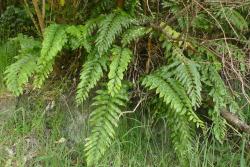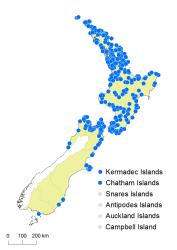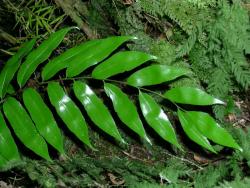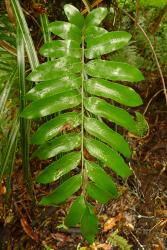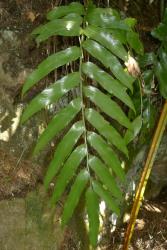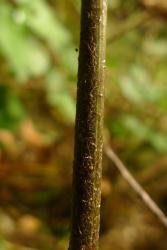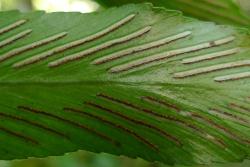- = Asplenium lucidum G.Forst., Fl. Ins. Austr. 80 (1786) nom. illeg., non Asplenium lucidum Burm.f. 1768
- ≡ Asplenium obtusatum var. lucidum (G.Forst.) Hook. & Baker, Syn. Fil. 207 (1867) nom. illeg.
- ≡ Tarachia lucida (G.Forst.) Momose, J. Jap. Bot. 35: 315, t. 28–30 (1960) nom. illeg.
- = Asplenium lucidum var. paucifolium Hook., Handb. New Zealand Fl. 371 (1864)
- = Asplenium durvillei Mett. in Kuhn, Linnaea 36: 95 (1869)
- = Asplenium obtusatum var. integrifolium Szyszyl. in Wawra von Fernsee, Itin. Princ. S. Coburgi 2, 122 (1888)
Terrestrial, rupestral, or epiphytic ferns. Rhizomes stout, erect, or short-creeping, sometimes forming a woody mass above ground, bearing scales. Rhizome scales ovate or narrowly ovate with filiform apices, 15–35 mm long, 1.5–8 mm wide, pale brown, shining, clathrate. Fronds 70–1400 mm long. Stipes 25–780 mm long, dark brown to pale brown or rarely green, densely covered in acicular or subulate scales with very long filiform apices. Rachises brown abaxially, green adaxially, or green on both surfaces, scaly. Laminae 1-pinnate, ovate or elliptic, narrowed to a long undivided or rarely lobed terminal segment with serrate margins similar to the primary pinnae; laminae 45–800 mm long, 25–450 mm wide, dark green on both surfaces, glossy on adaxial surface, herbaceous, bearing scattered scales on abaxial surface, lacking hairs (although scales becoming hair-like); laminae very rarely undivided, ovate or oblong, 60–70 mm long, 15–20 mm wide, apices acute or acuminate, margins serrate, borne on stipes 30–55 mm long. Primary pinnae in 0–22 pairs below an entire or lobed stalked apical segment, not overlapping, ovate or narrowly ovate or narrowly oblong, the longest at or below the middle, 10–260 mm long, 10–55 mm wide; pinna apices acuminate to acute or rarely obtuse or rounded in small fronds, margins serrate to almost entire, bases cuneate and stalked. Sori away from margins; indusia 4–35 mm long, straight or curved away from costae on largest fronds; free margins of indusia entire. Mean spore size 33–38 μm long, 20–24 μm wide; perispores reticulate.
Asplenium oblongifolium is morphologically very similar to both A. obtusatum and A. decurrens, both of which have 1-pinnate laminae. It is distinguished by its thinner fronds, usually more acuminate pinnae, longer terminal pinna, hair-like rather than ovate stipe scales, and reticulate perispores. All three species can occupy coastal habitats, but unlike A. oblongifolium, neither A. obtusatum nor A. decurrens extend into inland areas.
Asplenium oblongifolium can also be confused with A. lepidotum and with small, 1-pinnate fronds of A. lyallii. It can be distinguished from A. lepidotum by its scales, which are more hair-like and generally absent from the adaxial pinna surfaces, and from 1-pinnate fronds of A. lyallii by its smaller spores (33–38 × 20–24 μm cf. 40–54 × 27–35 μm) and reticulate perispores.
Occasional aberrant forms have a greatly enlarged basal acrosopic lobe on the primary pinnae, or primary pinnae that are divided into numerous lobes; such forms are rarely fertile. Crested fronds dividing repeatedly at the apices are also known.
North Island: Northland, Auckland, Volcanic Plateau, Gisborne, Taranaki, Southern North Island.
South Island: Western Nelson, Sounds-Nelson, Marlborough, Canterbury, Otago, Southland.
Kermadec Islands, Three Kings Islands, Chatham Islands.
Altitudinal range: 0–750 m.
Asplenium oblongifolium occurs on the northern Kermadec Islands and Macauley Island (Sykes 1977; de Lange 2015), on the Three Kings Islands, and in coastal, lowland and montane areas throughout the North Island. It grows from sea level up to 750 m in the Rimutaka Range, although it is generally uncommon above 400 m. In the South Island it occurs in coastal and lowland areas of north-west Nelson and the Marlborough Sounds, extending to Greymouth on the west coast and Banks Peninsula on the east coast, with isolated records from coastal Otago. There are also records from Bluff (AK 181427–181428) whose location may have been confused and which need confirmation (Perrie & Brownsey 2016). The species ranges from sea level to over 600 m in the Burnett Range, north-west Nelson. It also occurs on the Chatham Islands.
Asplenium oblongifolium is usually a terrestrial or rupestral species, but is sometimes found growing epiphytically on tree trunks. It has been recorded growing on Cyathea medullaris, C. smithii, Dicksonia squarrosa, Coprosma chathamica, Cordyline spp., Metrosideros spp., Vitex lucens, and Carex secta stumps, as well as hanging from Astelia clumps. It occurs in kauri, podocarp, broadleaved, and beech forest, under mānuka, kānuka, Cupressus, and Pinus, on coastal cliffs and in coastal scrub, among Phormium, under gorse, and in grassland and open areas. It grows on the ground, on stream banks, among roots, on rocks, cliffs, banks, in road cuttings, on scoria and lava, on sand dunes, on rotten logs and stumps, sometimes in close proximity to the sea.
There is evidence that A. oblongifolium hybridises with A. bulbiferum, A. flaccidum subsp. flaccidum, A. flaccidum subsp. haurakiense, A. decurrens (as A. obtusatum subsp. northlandicum) (Brownsey 1977a), and A. hookerianum (Perrie & Brownsey 2004). The combination A. oblongifolium × shuttleworthianum was recorded from Macauley Island in the southern Kermadec Islands by de Lange (2015), but the specimen (AK 325824) is morphologically much closer to specimens of A. flaccidum × shuttleworthianum. However, A. flaccidum has not yet been recorded from the southern Kermadecs, and the identity of the hybrid remains in doubt. Some of the plants included in the cultivar "Maori Princess" may result from a hybrid between either A. oblongifolium or A. obtusatum and A. bulbiferum.
n = 72 (Brownlie 1958; Brownsey 1977b).
The long accepted name Asplenium lucidum Forst.f., used by Allan (1961), was shown to be a later homonym of A. lucidum Burm.f. and therefore illegitimate. It was rejected in favour of A. oblongifolium Colenso by Brownsey (1979). Combinations based on Forster’s name are also illegitimate. The name A. lucidum var. paucifolium Hook. is incorrectly formed and cannot be used, even though the varietal epithet is legitimate.
Asplenium obtusatum var. integrifolium Szyszyl. was described from Takapuna, Auckland. The apices of the upper pinnae were described as acuminate, and, together with the locality, this suggests that the plant was actually A. oblongifolium. However, Cheeseman (1906, 1925) did not mention this variety, and Allan (1961) merely listed it in the supplementary notes. No material is present in Szyszylowicz’s main herbarium in W (Amin Loecker, email 23.6.2016). In the absence of original material it is therefore impossible to be certain about its true identity.
Analysis of low-copy nuclear DNA sequences suggests that either A. oblongifolium or A. obtusatum is one tetraploid parent of the allopolyploid species A. lyallii and A. decurrens (as A. northlandicum) (Shepherd et al. 2008).



